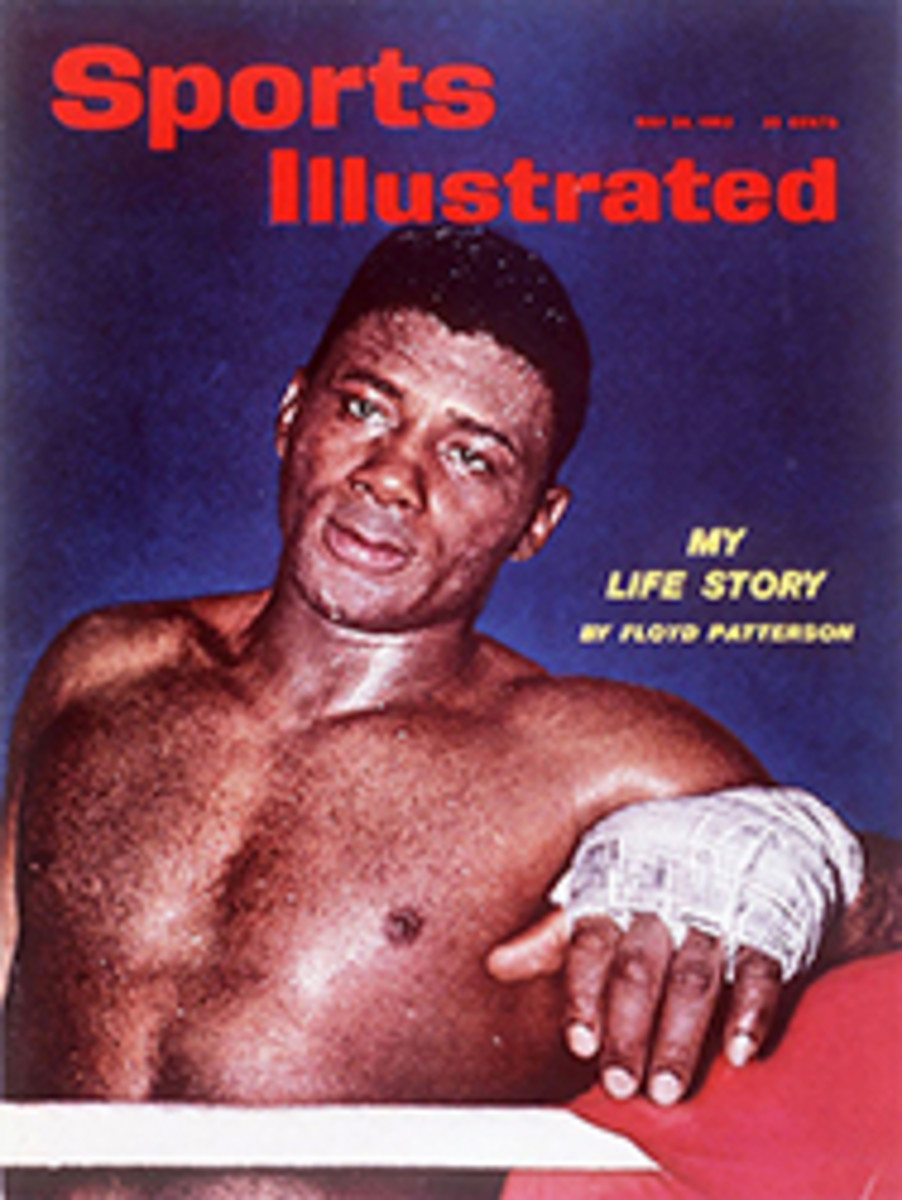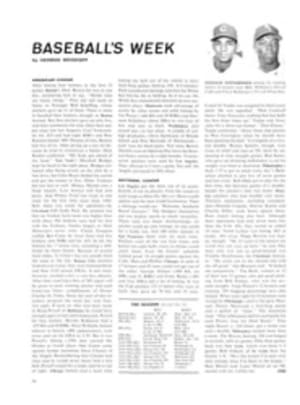
Batch of surprises in Los Angeles
It was, in a sense, a meeting of misadventures. The dark-visaged foreigner who won the year's most heralded footrace wasn't in the best of shape, but his foe made a grievous error. The discus ring was slippery and the wind was wrong. The shotputter thought his form was awful. But this was a night when athletes thrived on trouble. As 40,000 impressed spectators looked on Friday evening at Los Angeles Coliseum, Discus Thrower Al Oerter and Shot-putter Dallas Long both broke world records, and New Zealand's Peter Snell ran America's fastest mile, whipping this country's best man at the classic distance, Dyrol Burleson.
It was two days before that thick-legged, muscular and normally super-confident Snell—the awesome holder of the mile and half-mile world records—had arrived in Los Angeles for his last U.S. appearance of the year. He flew in from Honolulu, where he had been working out for several days under the careful eye of his coach, Arthur Lydiard. He was not in peak condition, his training having been hampered by an inflamed tendon in his right knee.
"I had to bring myself up to a new peak for this race," he said later. "Our season is over. But I wanted very much to be ready for this one." He had not learned that Burleson would be in the race until early Wednesday when a sports-writer called him and awakened him with the news. He seemed a bit apprehensive at first; both Snell and Lydiard consider Burleson the best miler in the world—next, of course, to Peter Snell.
By race time Friday, however, Snell had calmed his fears and said that he was glad to be running against Burleson. "It would be a shame to come this distance and not meet your best runner," he added. Though Burleson had wanted very much to run against Snell, his entry in the Coliseum Relays was a last-minute surprise. Bill Bowerman, his coach, had not felt that the Oregon collegian was far enough along in his training to take on Snell, and Burleson had a race to run for his college team on Saturday. Finally, at 6 o'clock on Wednesday morning—Bowerman is an early riser who makes most of his decisions at dawn—the Oregon coach elected to let Burleson compete in the mile at Los Angeles.
Honey and pigeon feed
"I like this kind of race," said Burleson frankly the morning of the event. "I've got everything to gain and nothing to lose." He was having breakfast in the small coffee shop of the Sheraton-West Hotel: a healthy meal of two poached eggs and toast, plus a cupful of honey, his only bow to the dietary idiosyncrasy that so many runners affect. With him was his wife, Caroline, who was more intent on saving her English muffin than eating it. "She's a pigeon feeder," said Burley fondly. "After breakfast we'll walk across the street to the park and she'll give the muffin to the pigeons."
Then he explained his training program, and it indicated why he was not ready for Snell. It is a regimen that closely parallels Snell's—Bowerman and Lydiard being close friends who exchange training ideas. But since the track seasons are different in the U.S. and New Zealand the runners reach top condition at different times of the year.
"Early this year I started long slow running," Burleson said. "I work twice a day. You have to now if you want to be of world class. I start at 7 in the morning and run for an hour and a half and then I run another hour and a half in the evening, after classes. I'm just now changing to speed work. I won't be completely converted until the week of the NCAA meet.
"This is a long-range program I'm working on. I'm getting ready for the Olympics. Each year I'm a little stronger. Each year I start a notch farther up the ladder. Til break my routine right after the season, then start hard training again next January. You have to do more and more all the time." With that, he and Caroline went to feed a muffin to the pigeons.
It was cool and still at the Coliseum that night when the starter's pistol set the field of six off on the mile. Burleson was running easily with that long, fluid stride that moves him over the ground with the graceful economy of a trotting horse, while Snell was chewing away the yards in his powerful, pounding fashion. That neither led in the first three laps meant nothing.
But, with 220 yards to go, and Snell two yards ahead of Burleson, the crowd began to yell. It was well aware that Burleson's strength is a great finishing sprint, and it expected that now, in the backstretch of the last lap of what was obviously going to be a very fast mile, Burleson would be able to use his speed to run Snell down.
It was Snell who sprinted, however. He opened up just as the runners approached the last turn, and he gained five yards on the surprised Burleson in the first 20 yards of his drive, accelerating with amazing speed. Burleson kicked, belatedly, and for a few seconds, around the turn, he seemed to be closing the gap Snell had opened. But as they came out of the curve into the final straight Snell, running like a sprinter instead of like a miler finishing a tough race, pulled away again. At the finish line he was 10 yards ahead. His time was 3:56.1, not close to his world record 3:54.4, but remarkable nonetheless.
Despite the margin of Snell's victory, it is quite possible that Burleson can someday beat the New Zealand runner.
Snell ran the final 220 in 24.5 seconds, astounding time for the finish of a mile. Burleson ran his last furlong in 26 seconds. "That should be fast enough to beat anyone," he said after the race. "But not Snell. I should have made my move at the quarter, instead of waiting. When he went swoosh as he broke into his sprint I knew I had made my mistake." Burleson's time was 3:57.9, the second best of his career.
Present for Peter
Immediately after the race was over Snell commented on Burleson's mistake. "It was a gift from heaven, Burley not going all out for the whole last quarter," Snell said gratefully. "I don't know if I am fit enough to have stood him off if he had."
Snell seemed barely winded by the race, despite the 54-second last quarter he had run. He was upset because he had not been given his lap times. Both he and Burleson thought the race would have been faster if they had known their times for each quarter. And he explained he had delayed his finishing kick somewhat, because he was not too sure of his condition. "I was worried if I started my kick too soon I'd be outfinished by Burleson," he said. "I started my move going into the bend so that he would have to swing wide if he should go around me. I had my eye on him all the way."
The mile was the climax of a meet at which some 30 records of various kinds were broken.
And it was properly the climax since Burleson and Snell won't meet again this year. But, considering the conditions, the best single performance of the night was very likely Al Oerter's world record for the discus.
Discus throwers prefer to sail their projectile into a slight wind so that it will plane. On this night there were light gusts of fitful wind during the discus competition, but not enough to help. What's more, as Oerter noted after his 200-foot 5½-inch throw, "the ring was so slippery I nearly fell on every throw." Slippery rings may become a vogue, no one having thrown the discus more than 200 feet in recognized competition before.
Oerter, who won the discus throw at both the Melbourne and the Rome Olympics, now hopes to add a third title in Tokyo. Until the last few months, though, he had lost interest in competition. "Jay Silvester aroused me again when he threw the discus 210 feet last year," Oerter said (Silvester's throw was not allowed as a record, because the range suffered from a most pertinent deficiency: it sloped downhill). "Now I'm going for the Olympic triple."
A terrible toss
Al Oerter was not the only one who surprised himself. USC's big man, Dallas Long, a 6-foot-4, 245-pound mound of muscle, knelt down and nervously rolled the metal ball around on the Coliseum sod, a rare display of the fidgets for him. Then he hefted it over to the shotput ring and threw it 65 feet 10½ inches, a half inch more than Bill Nieder's world mark.
"The throw that broke the record felt terrible," he said afterwards. "I spun around after I let go of it, and I didn't have my weight over my right leg the way I should. But I'll take it anyway. I guess this was just the night it had to come."
Oerter, who had finished the discus competition earlier in the evening, was sitting on the grass watching the shot-putters. When Long broke the record he shook his head in wonder. "I guess there isn't any limit," he said. "They keep coming bigger and stronger all the time." And faster, too, Al.
PHOTO
VICTORIOUS SNELL wondered if he could have won if he had been forced to start sprinting sooner.

